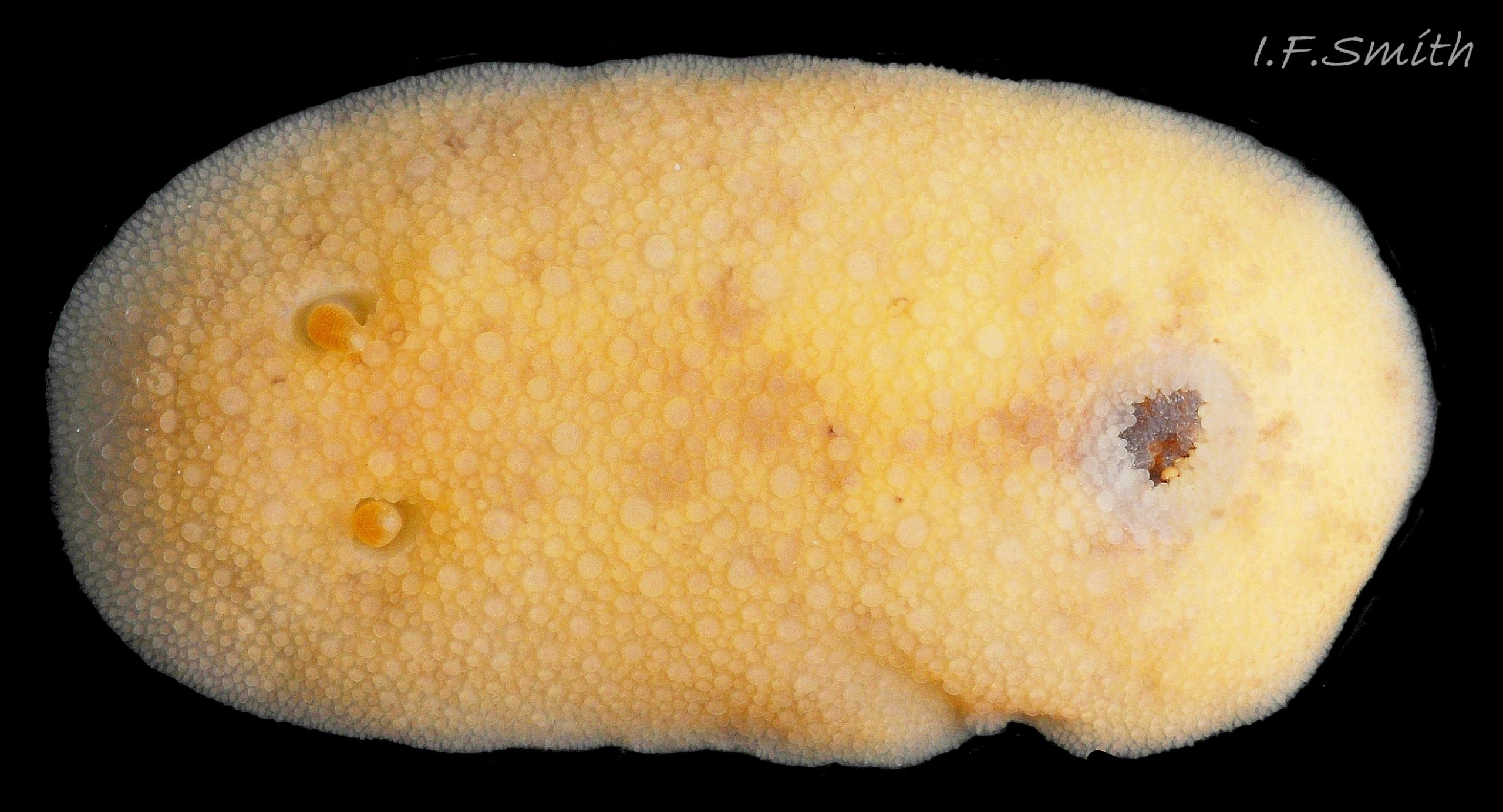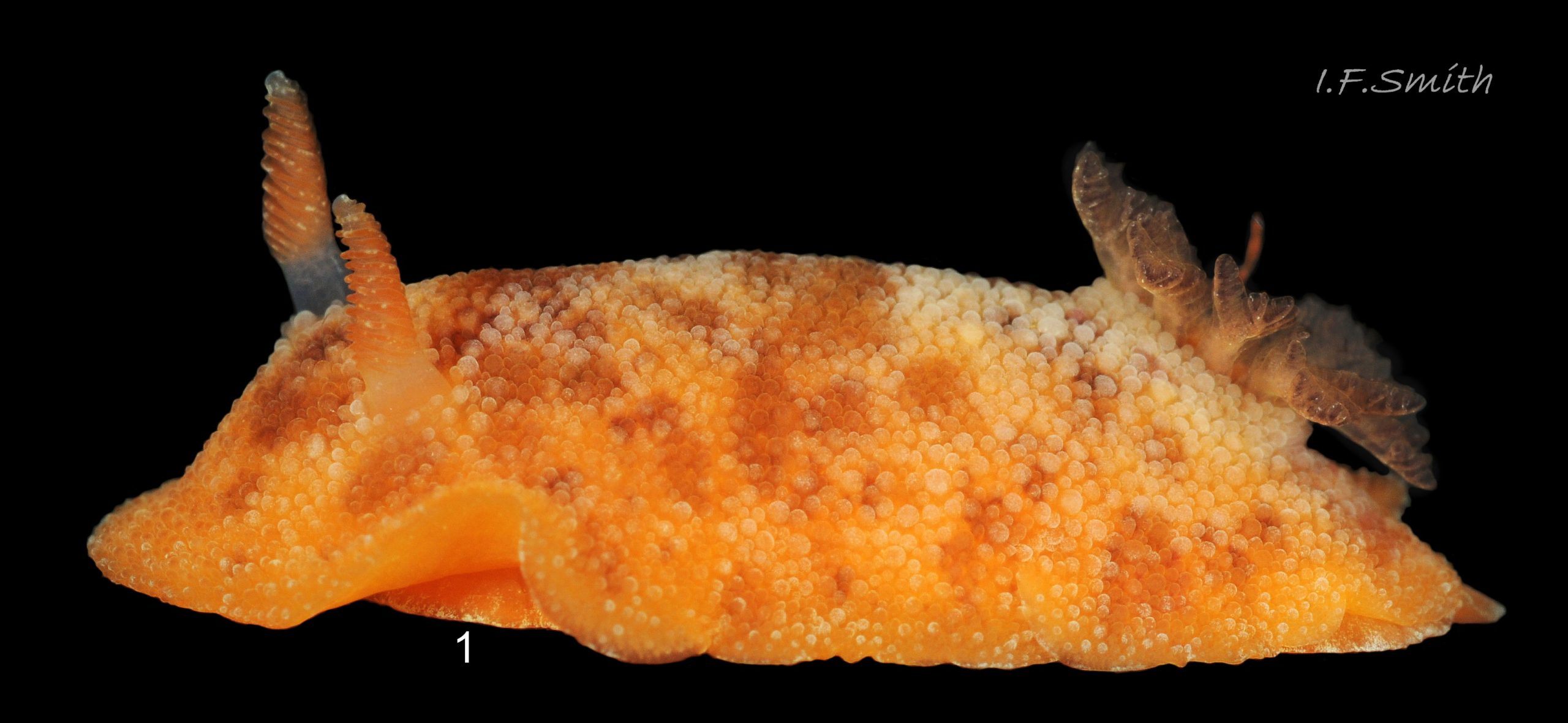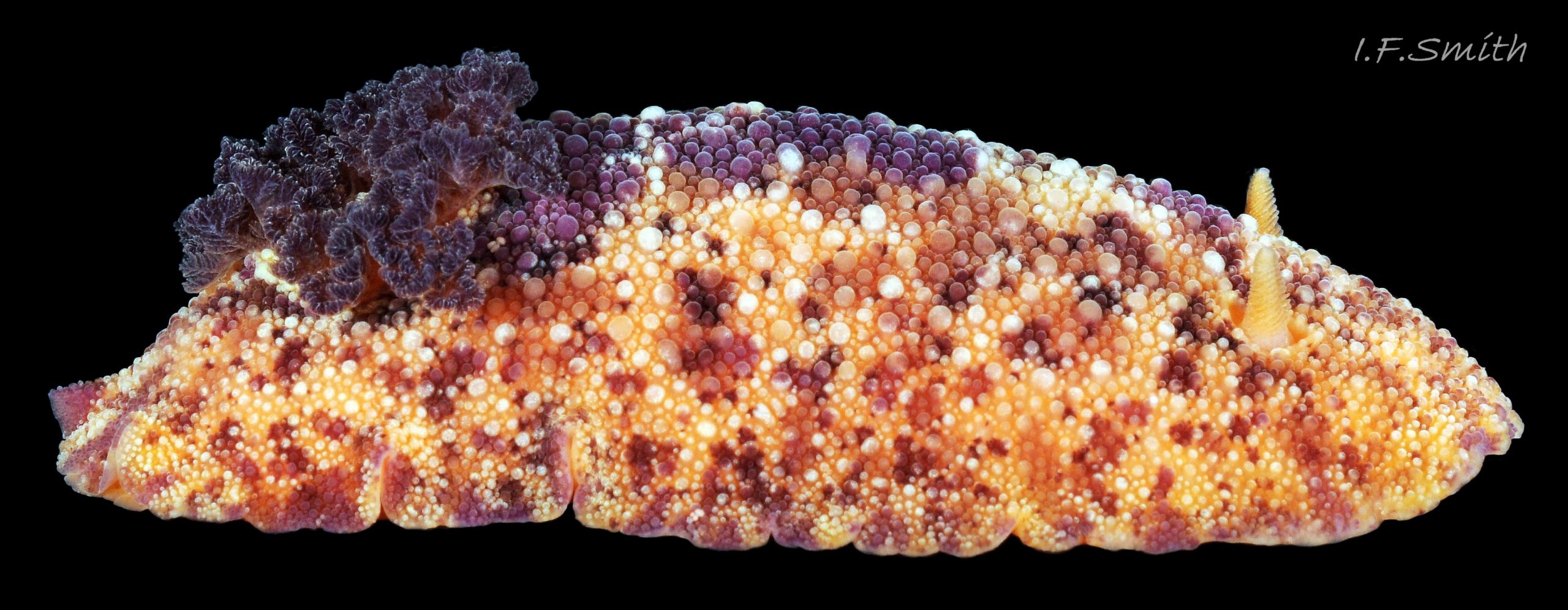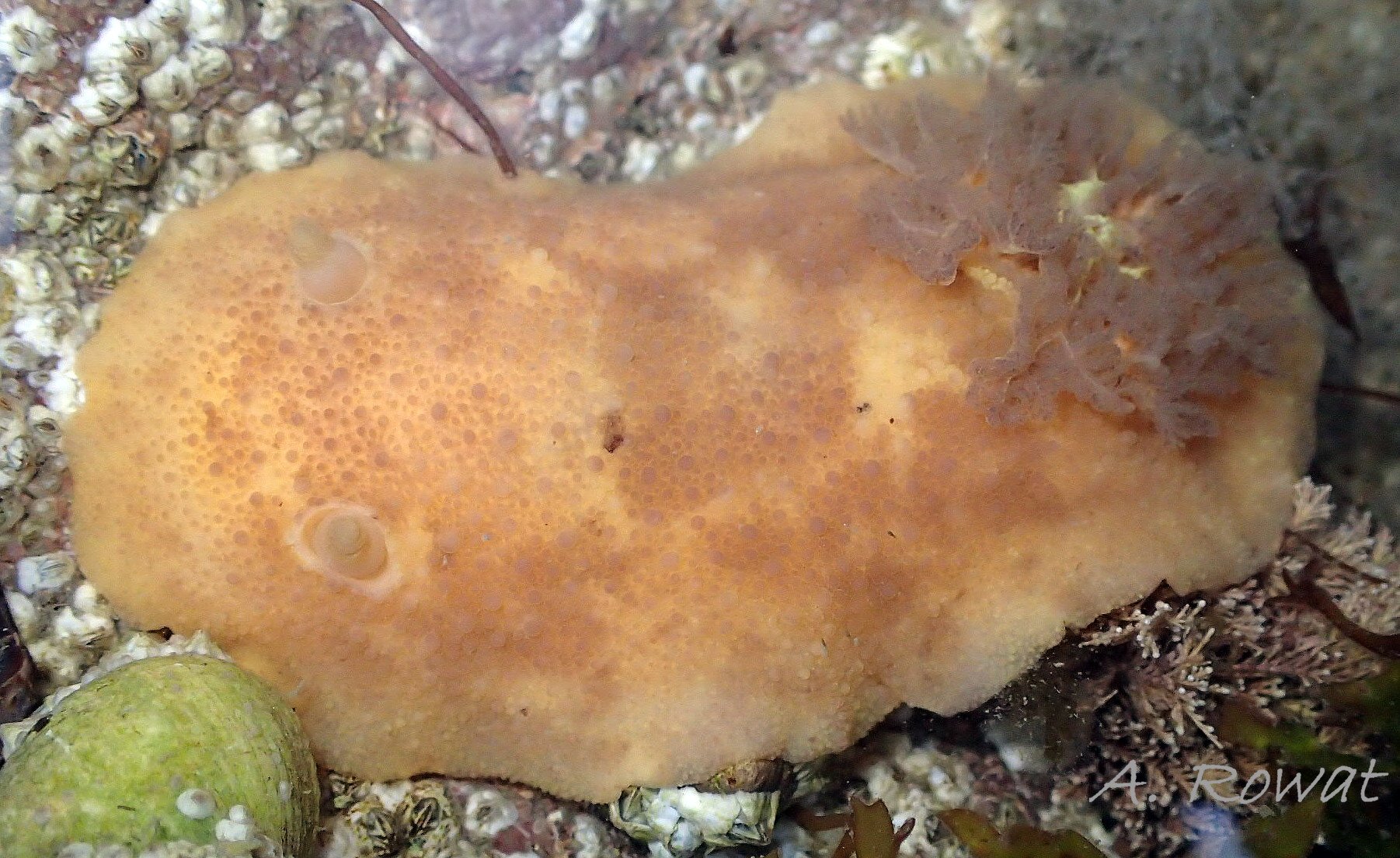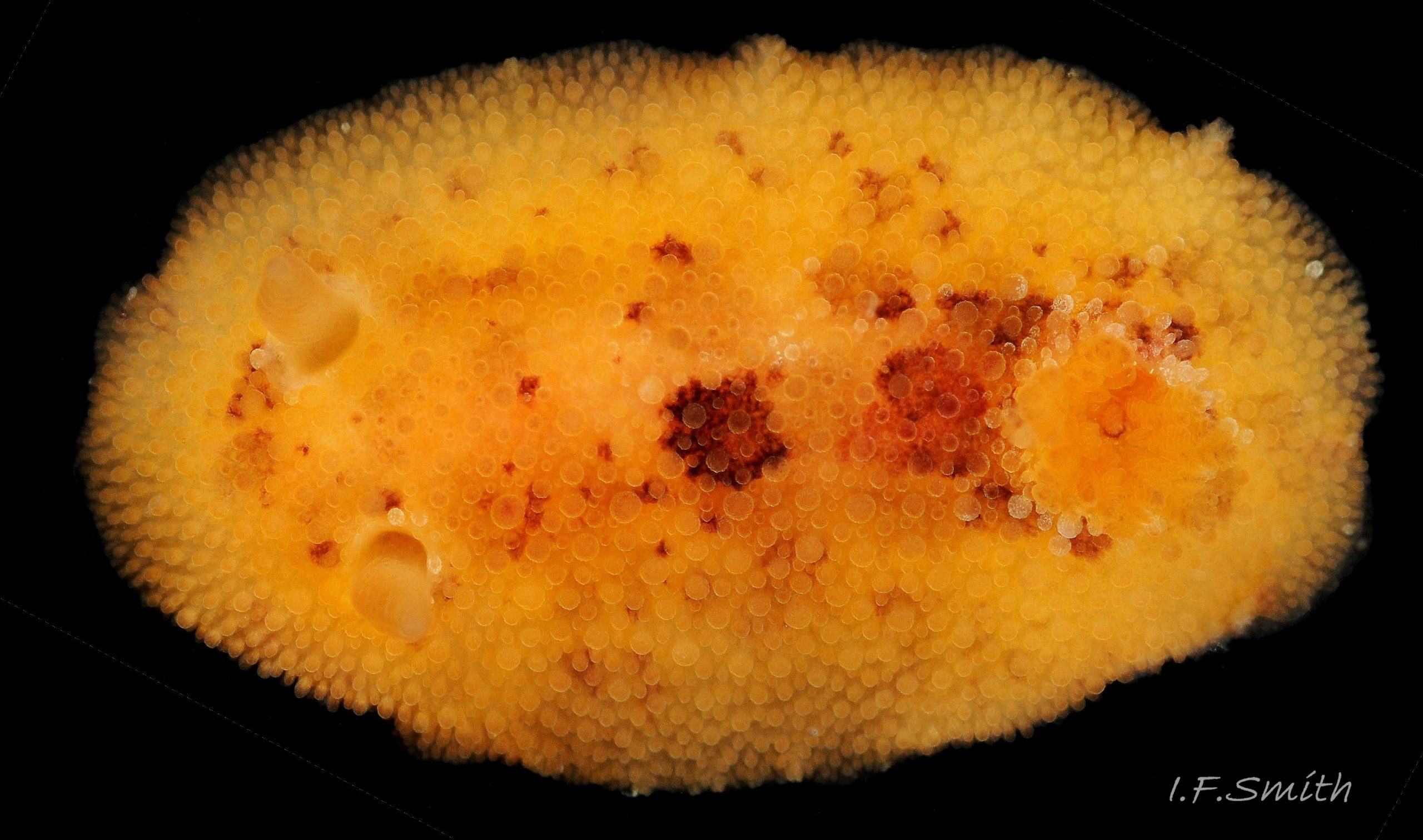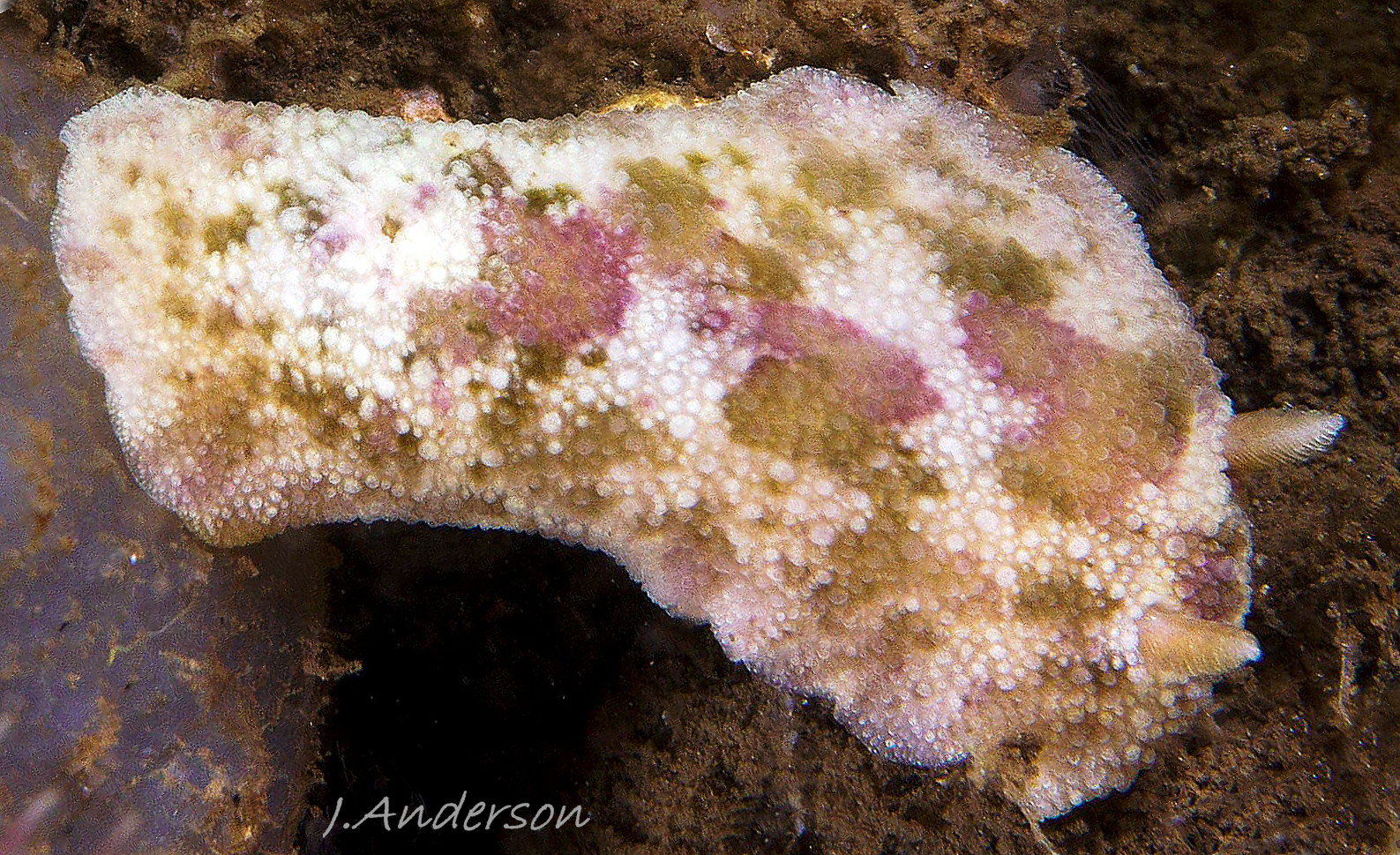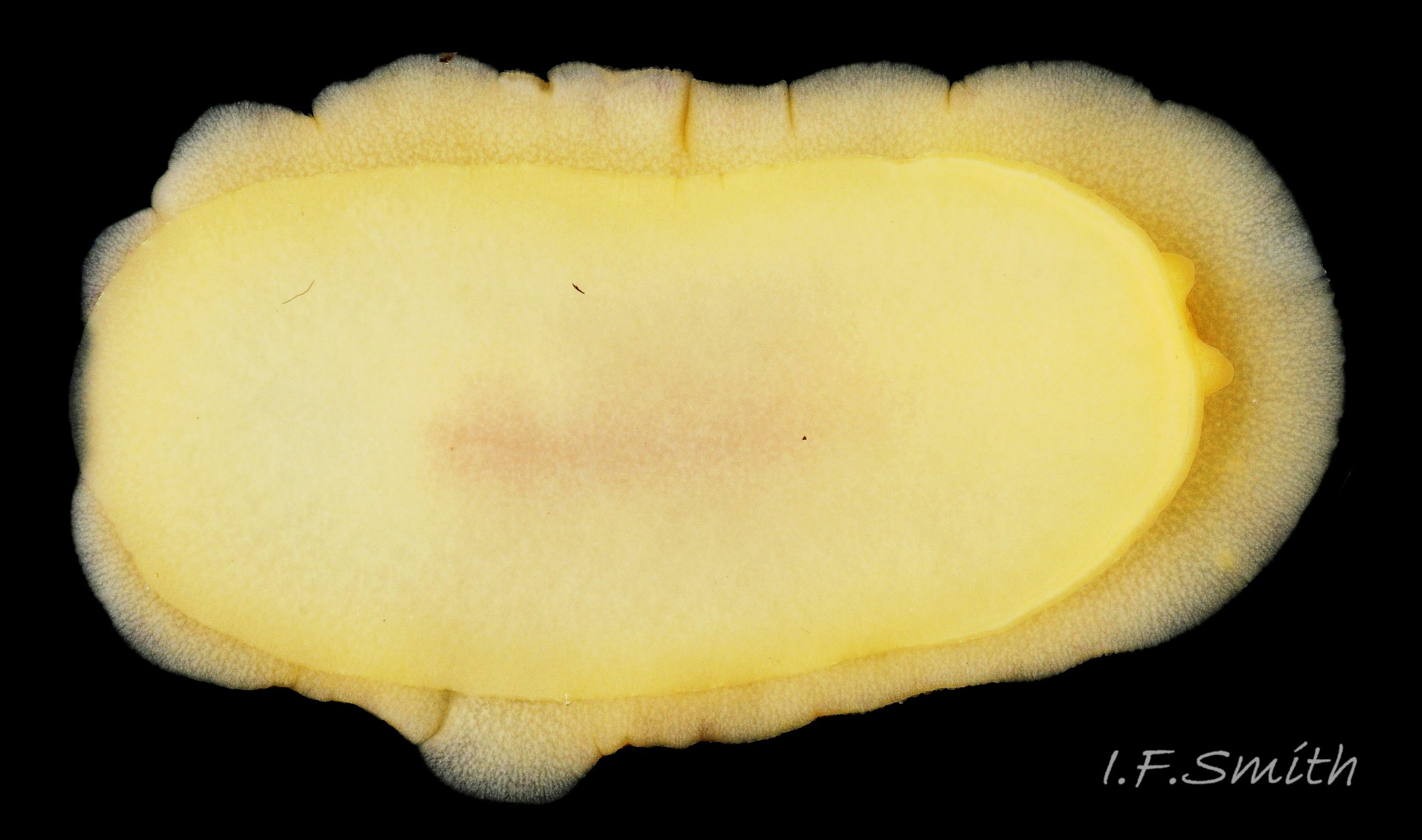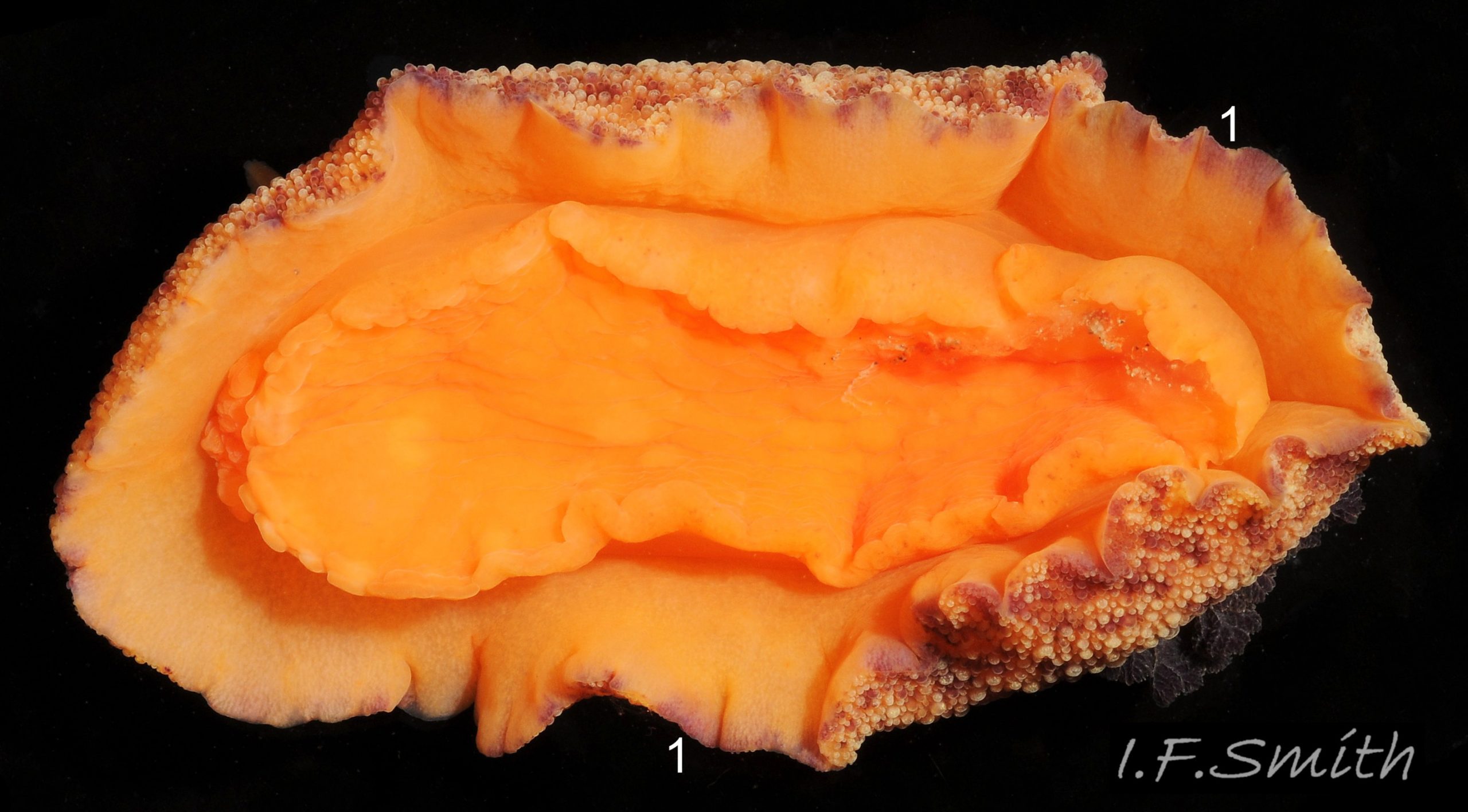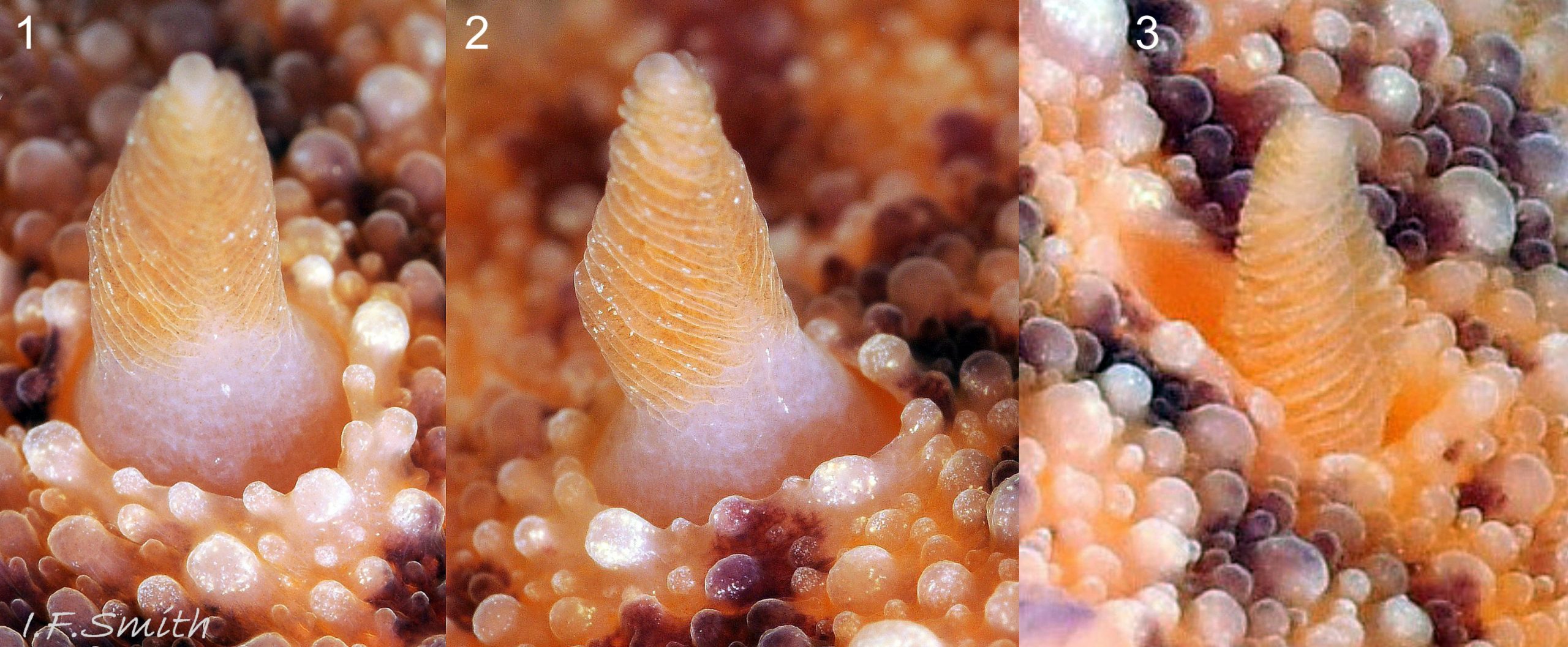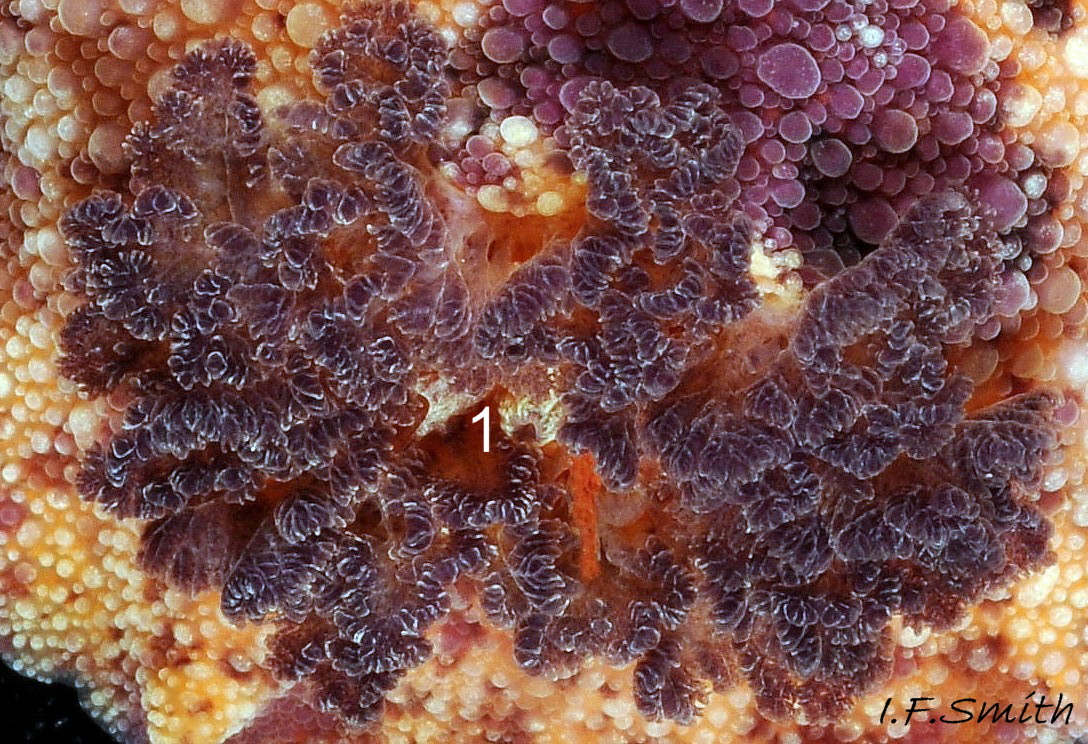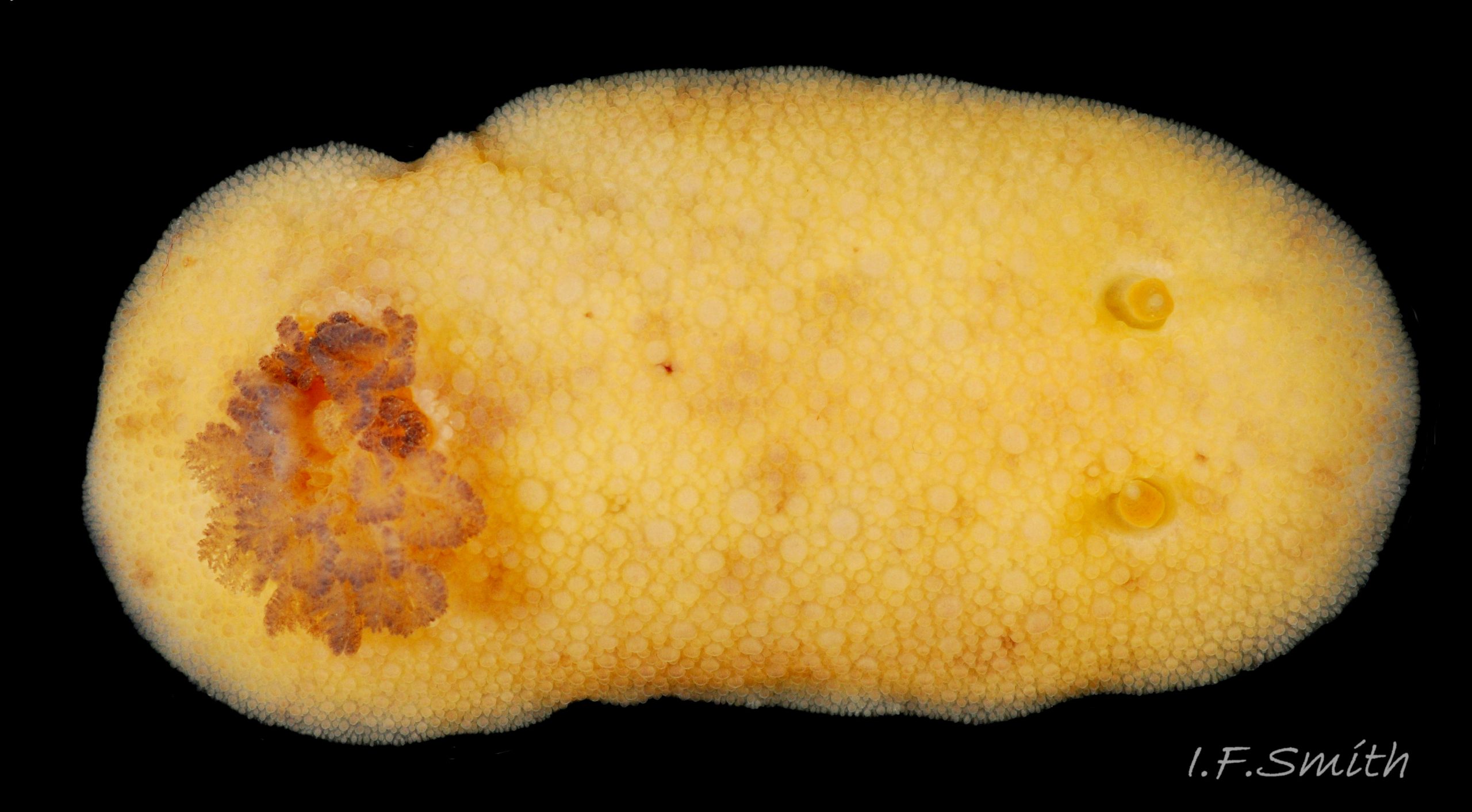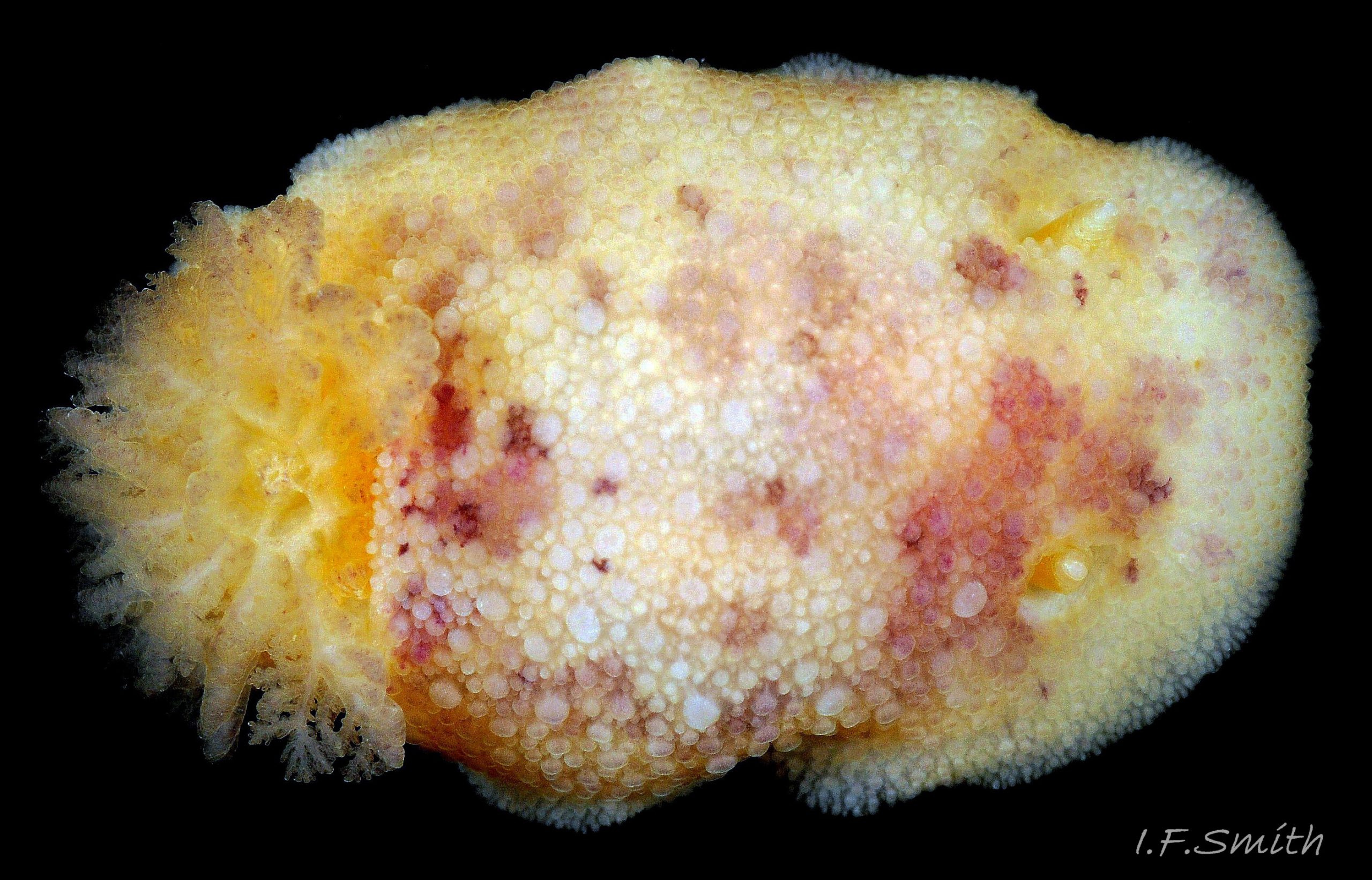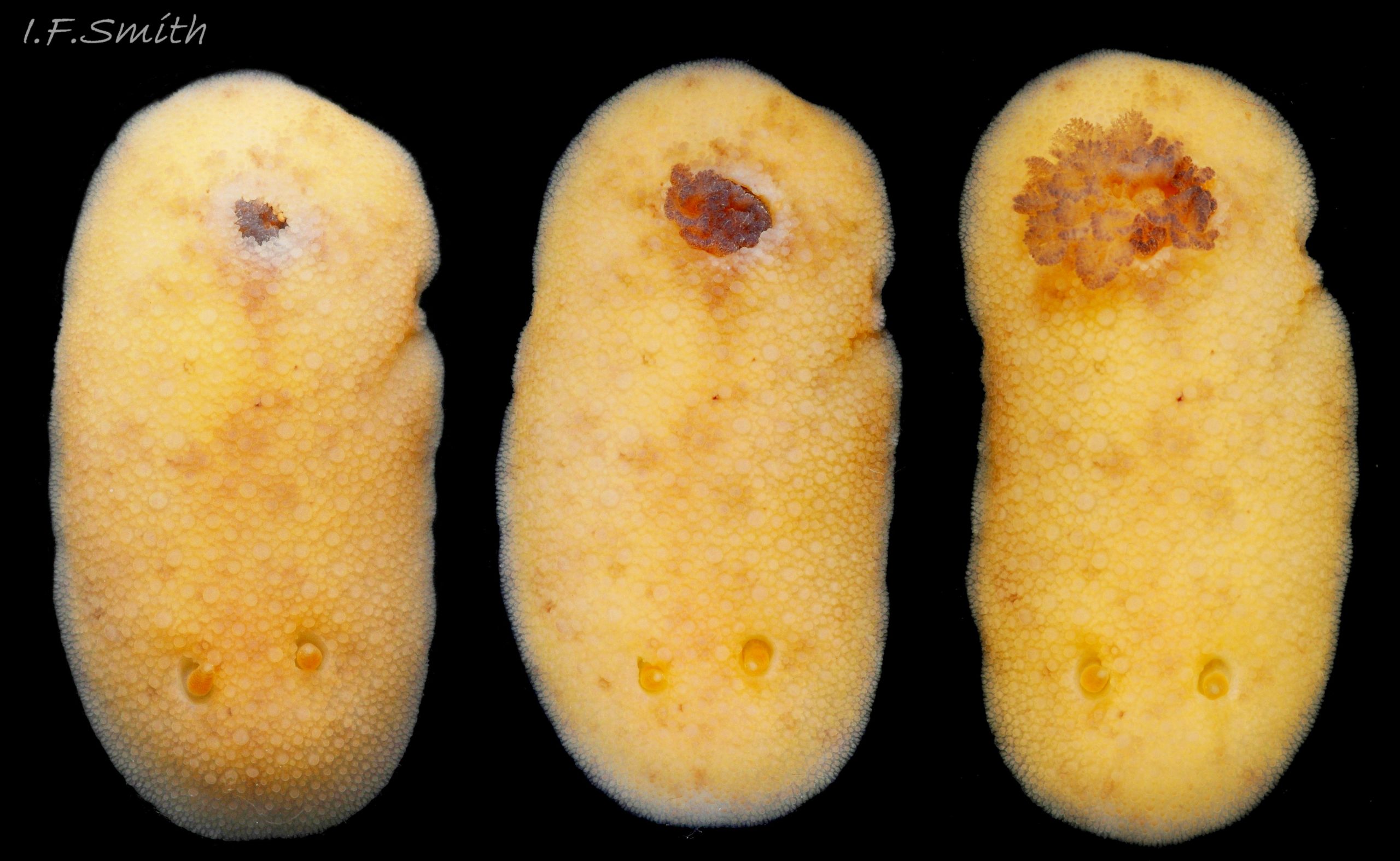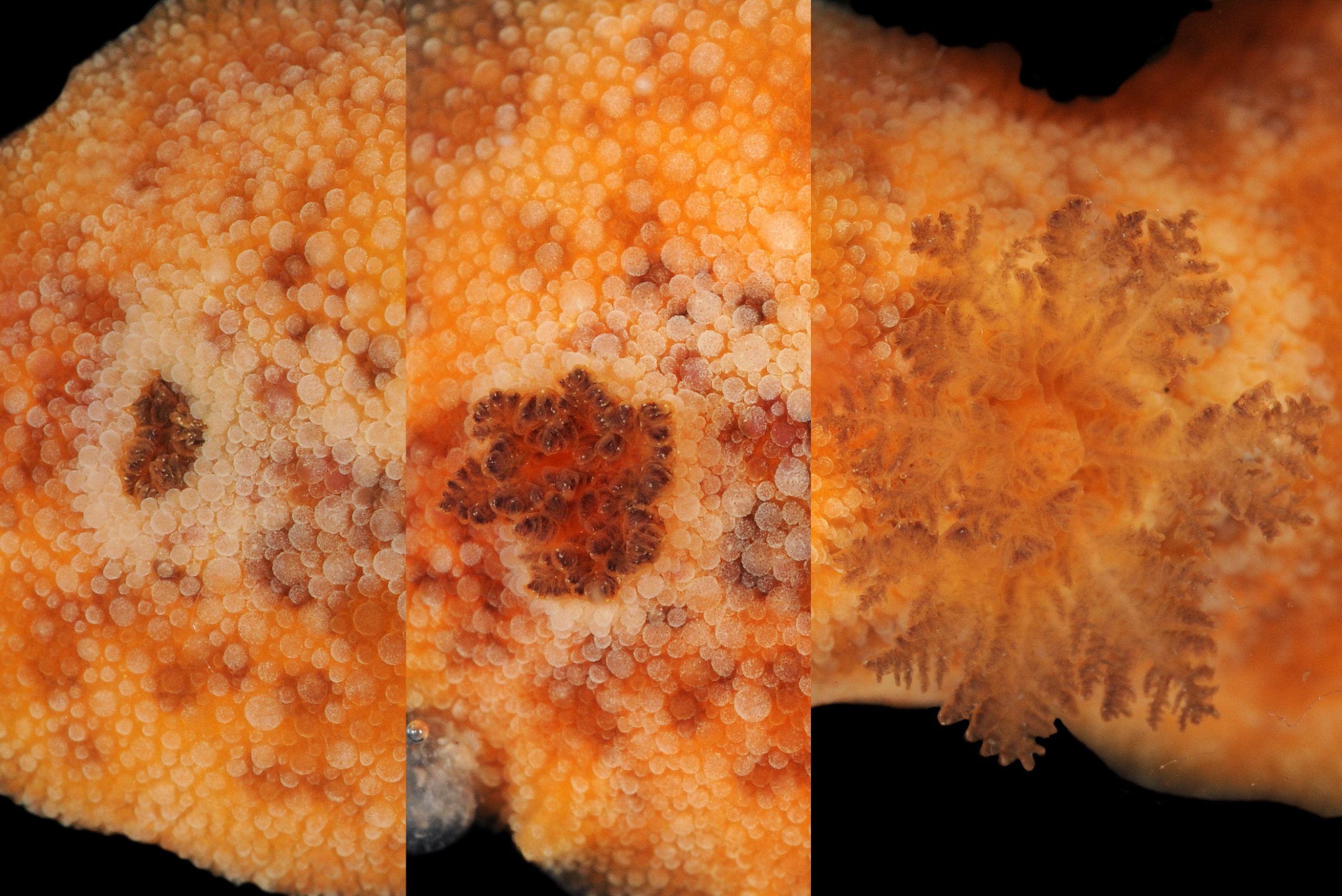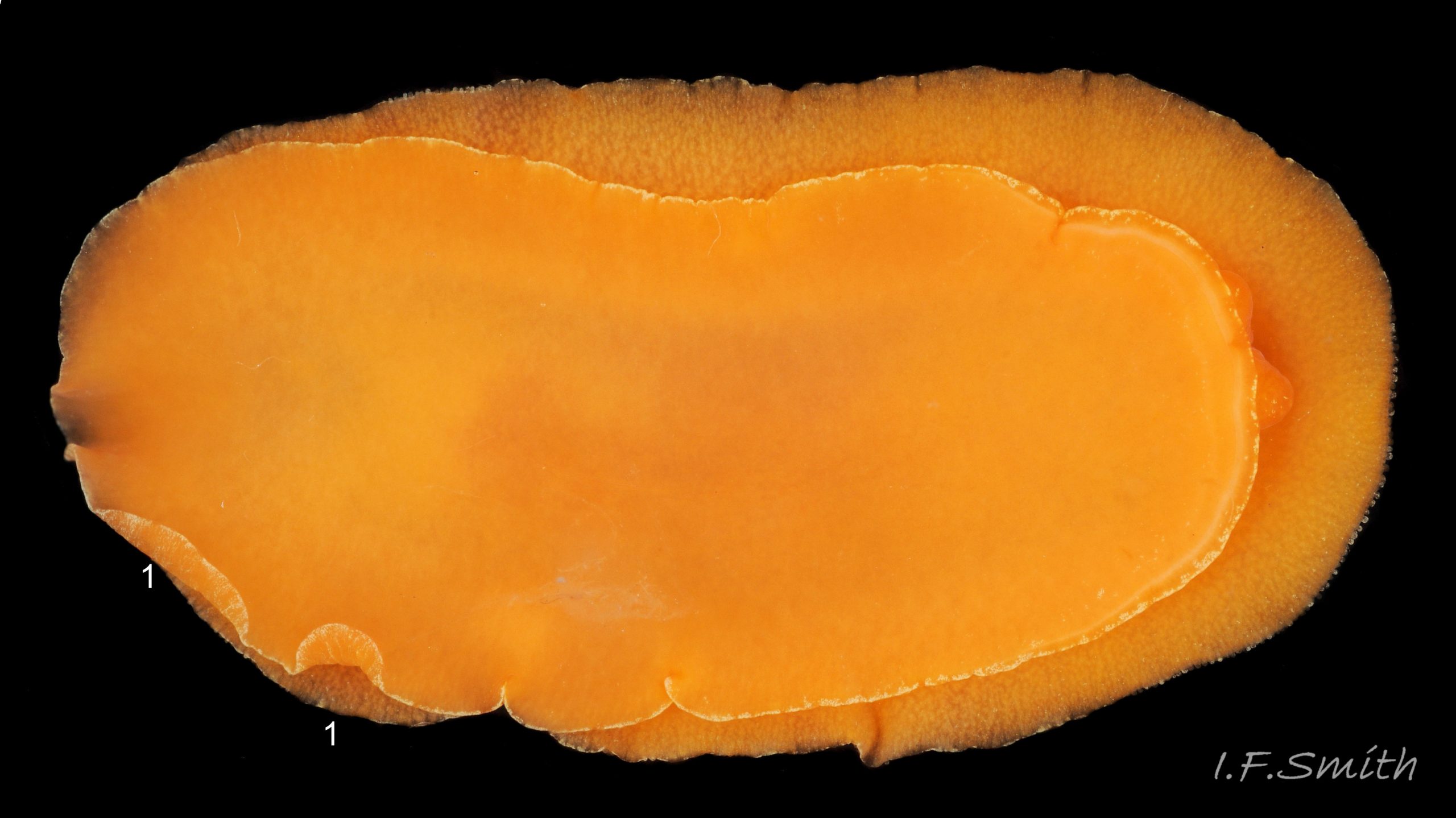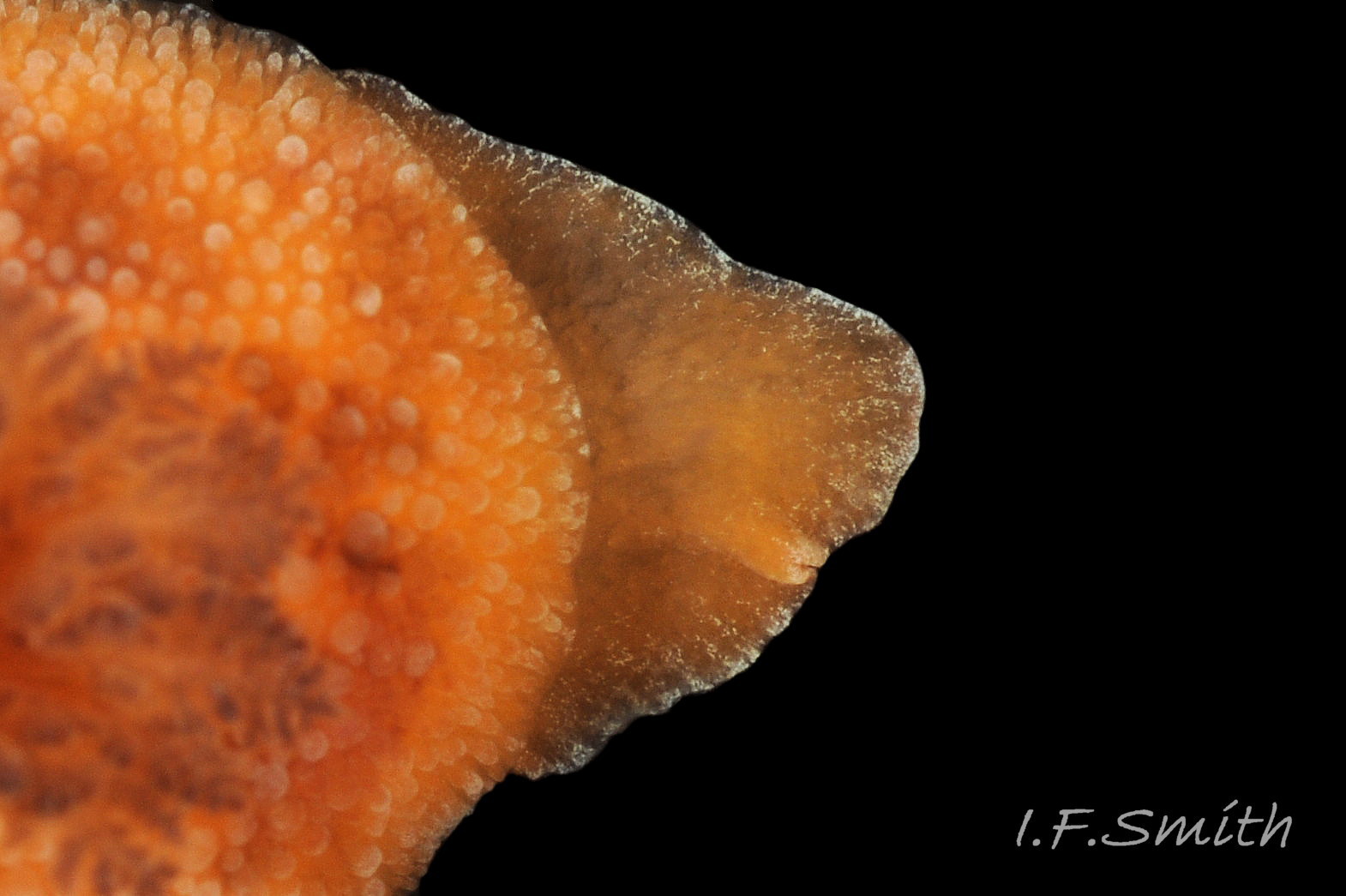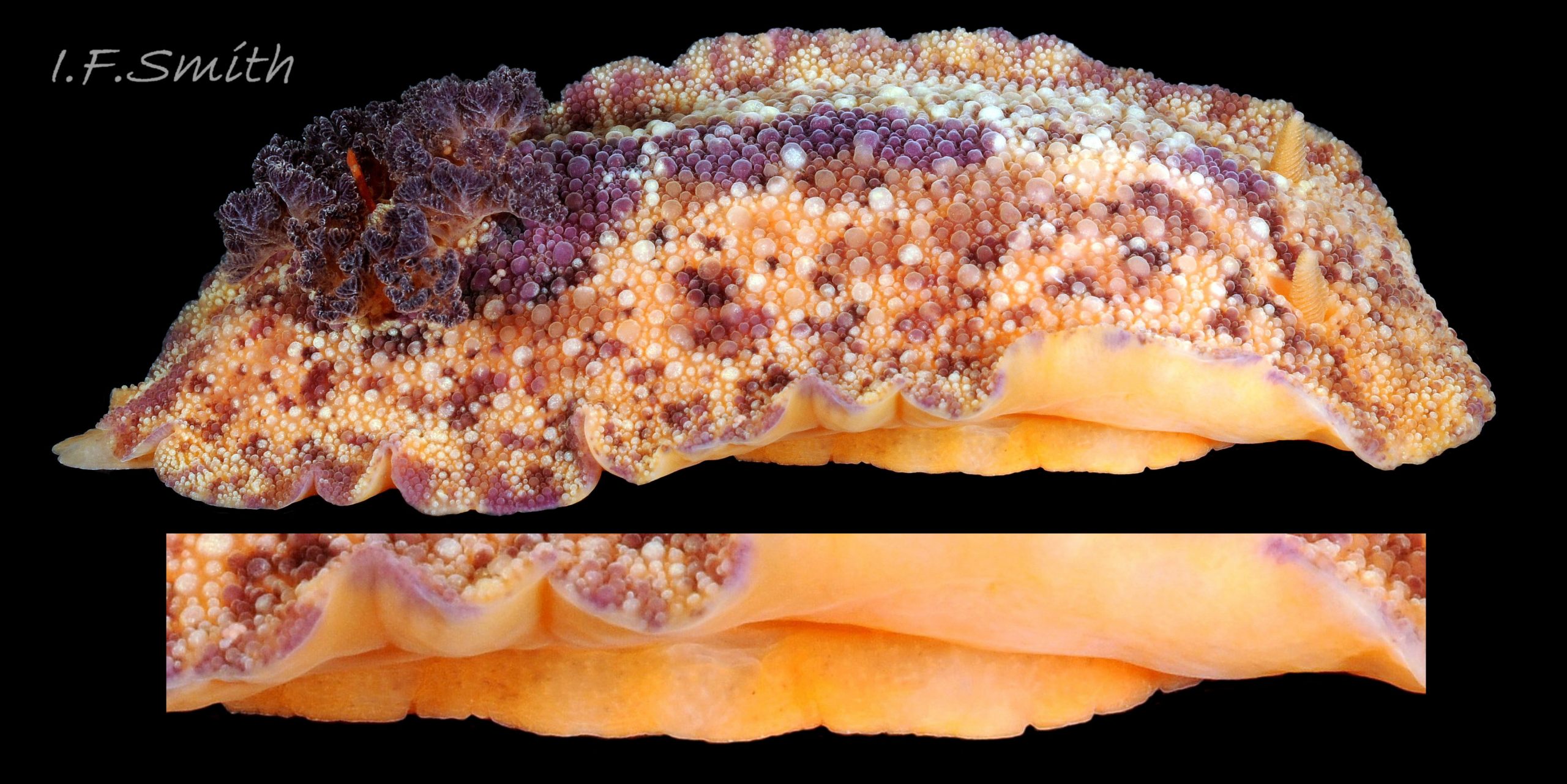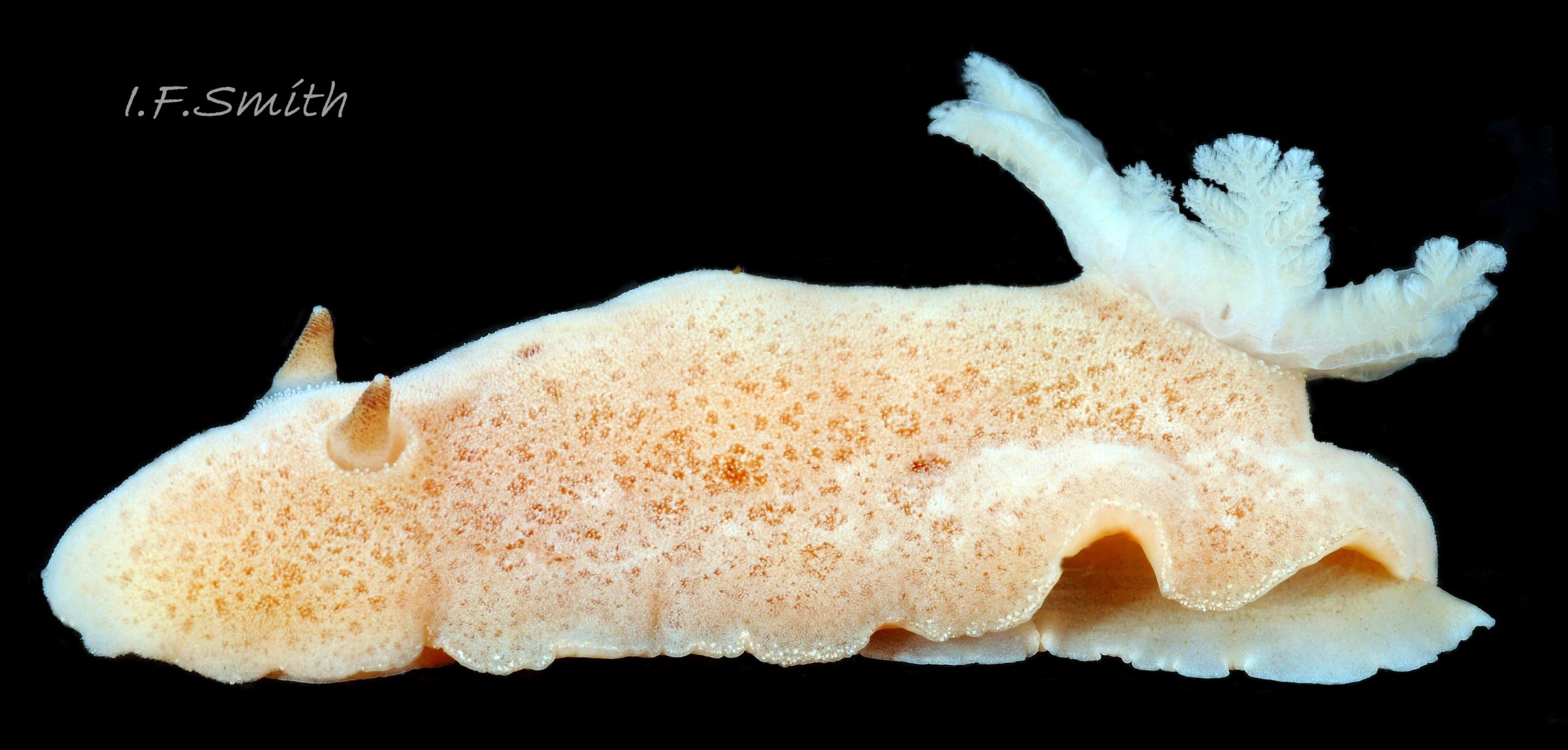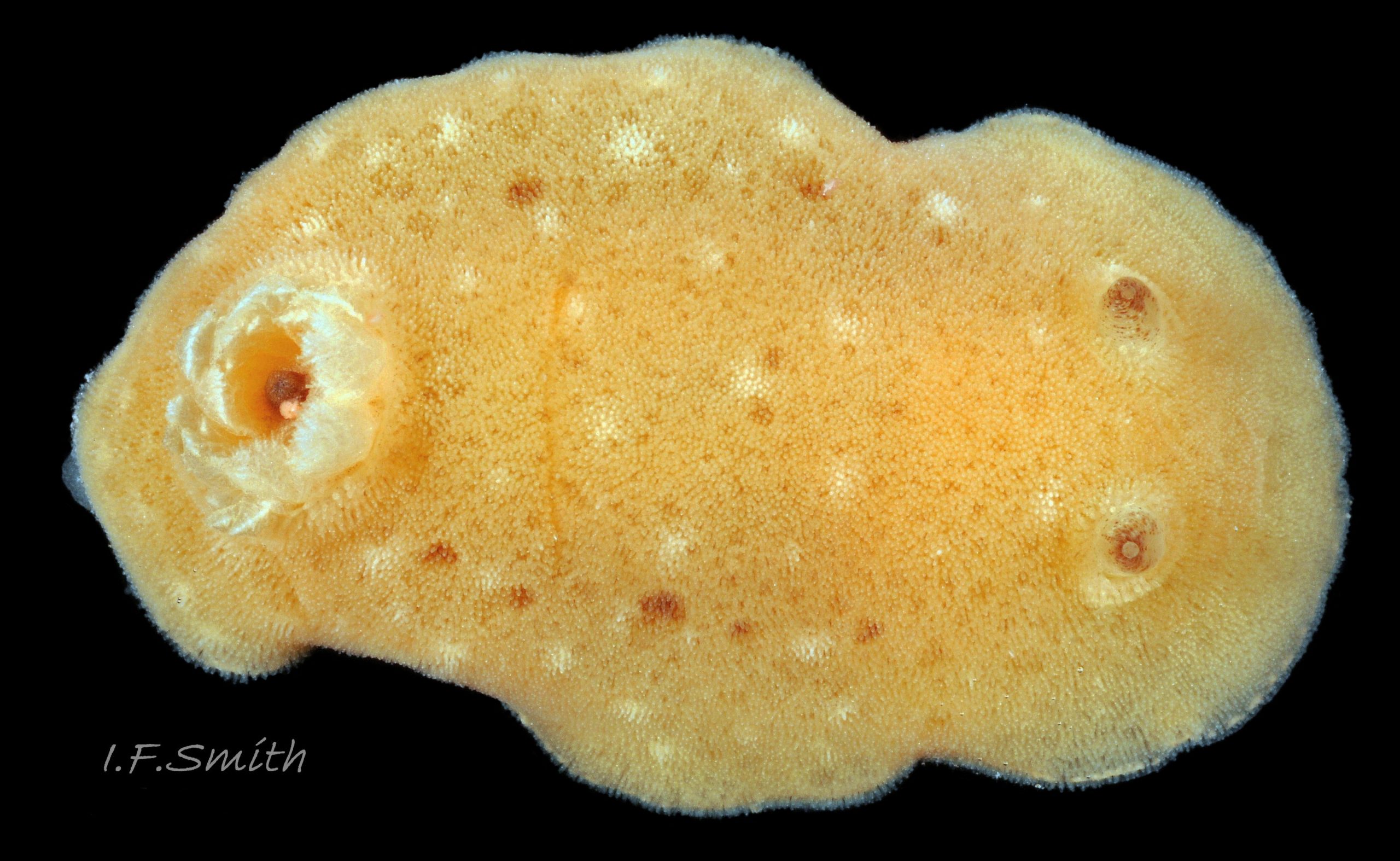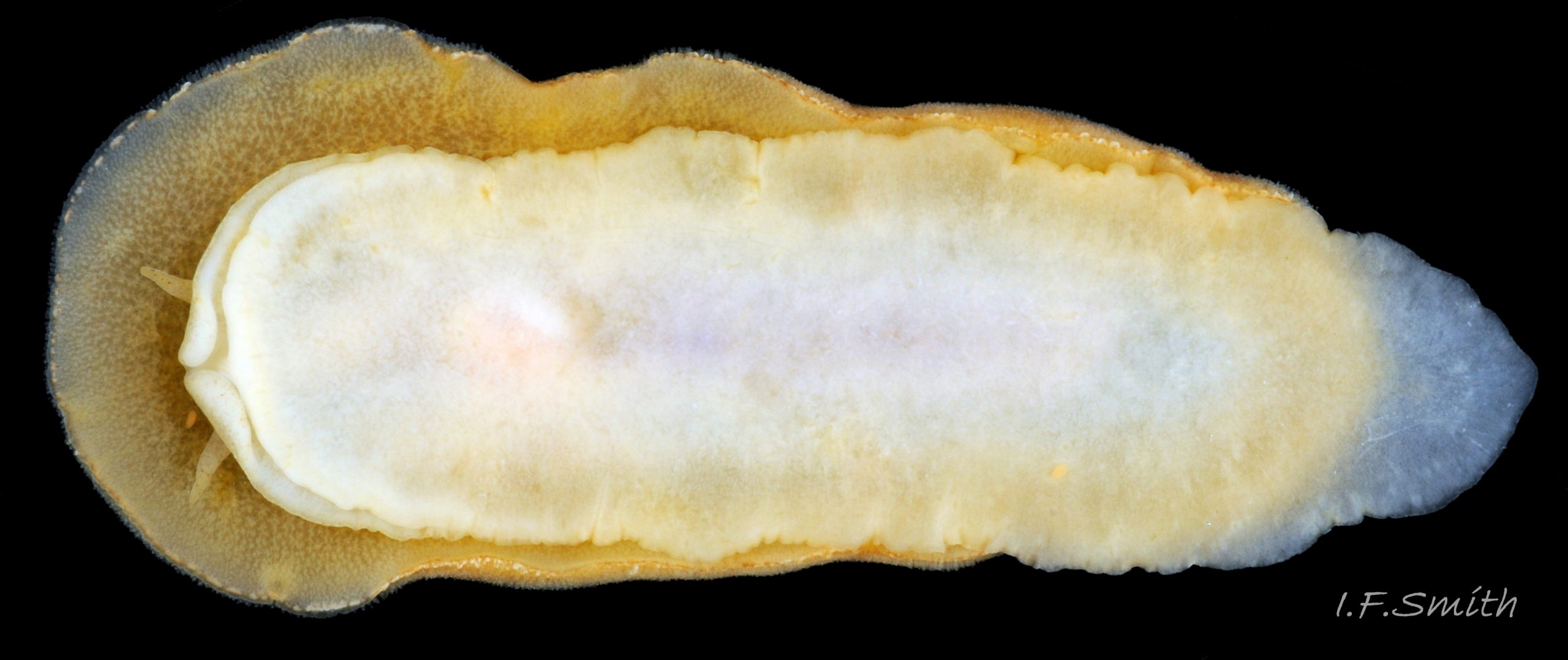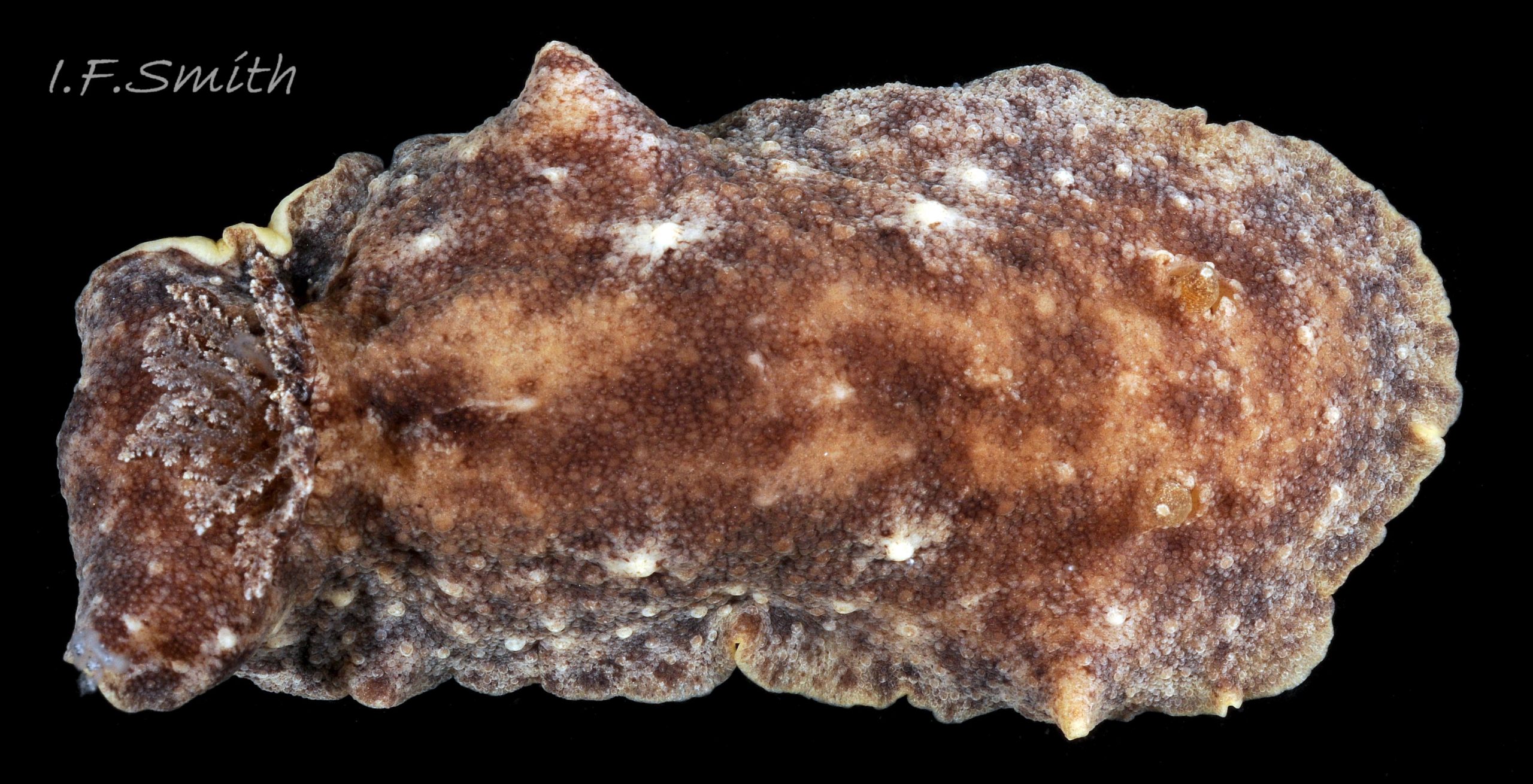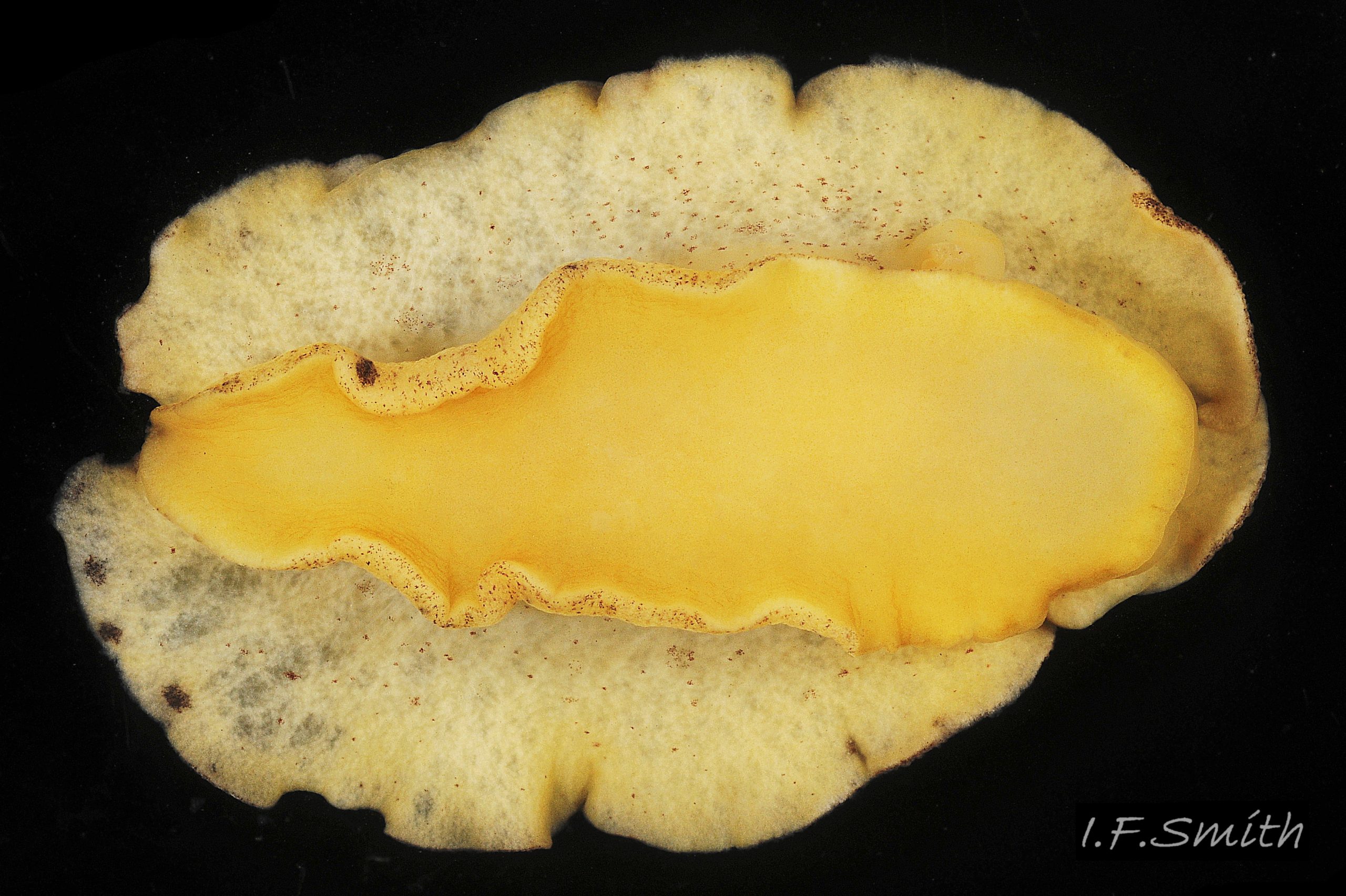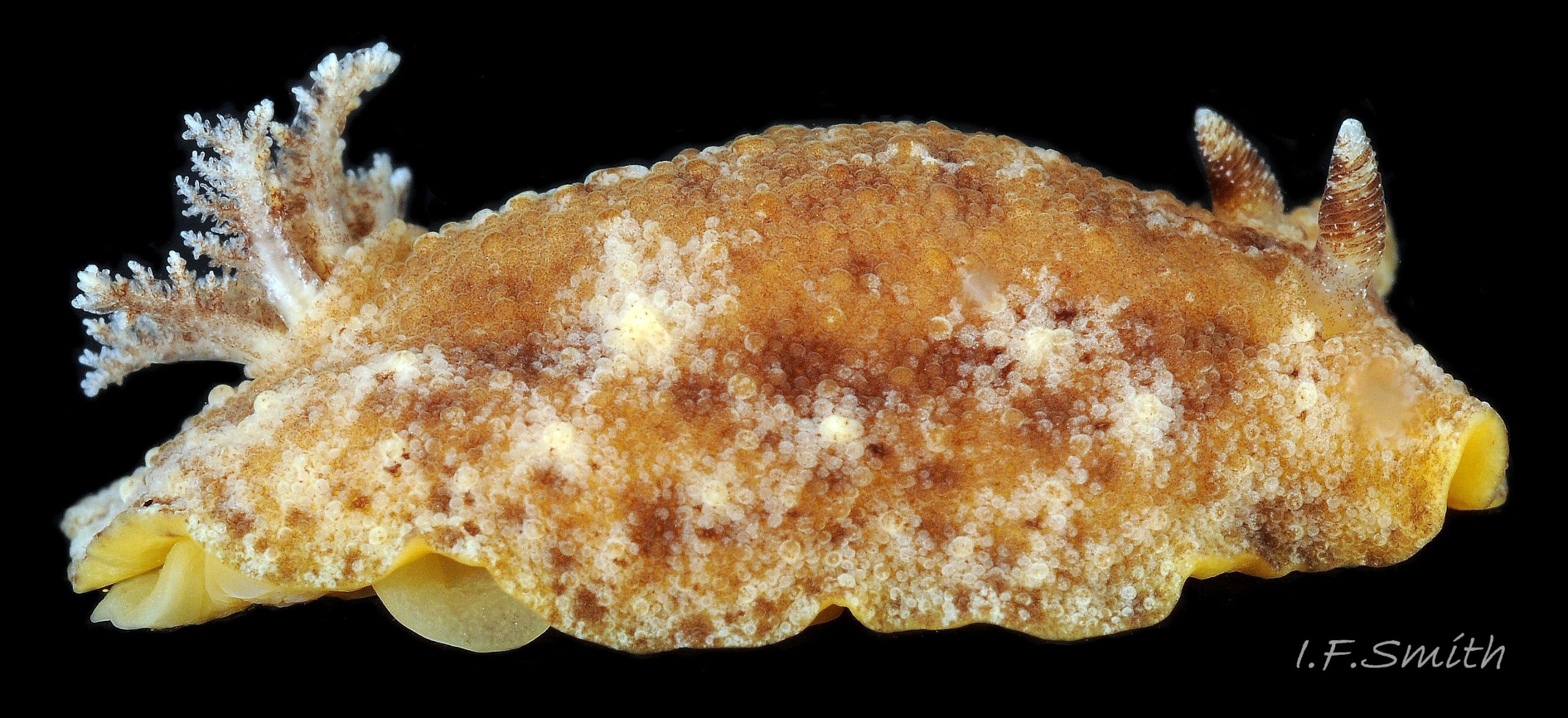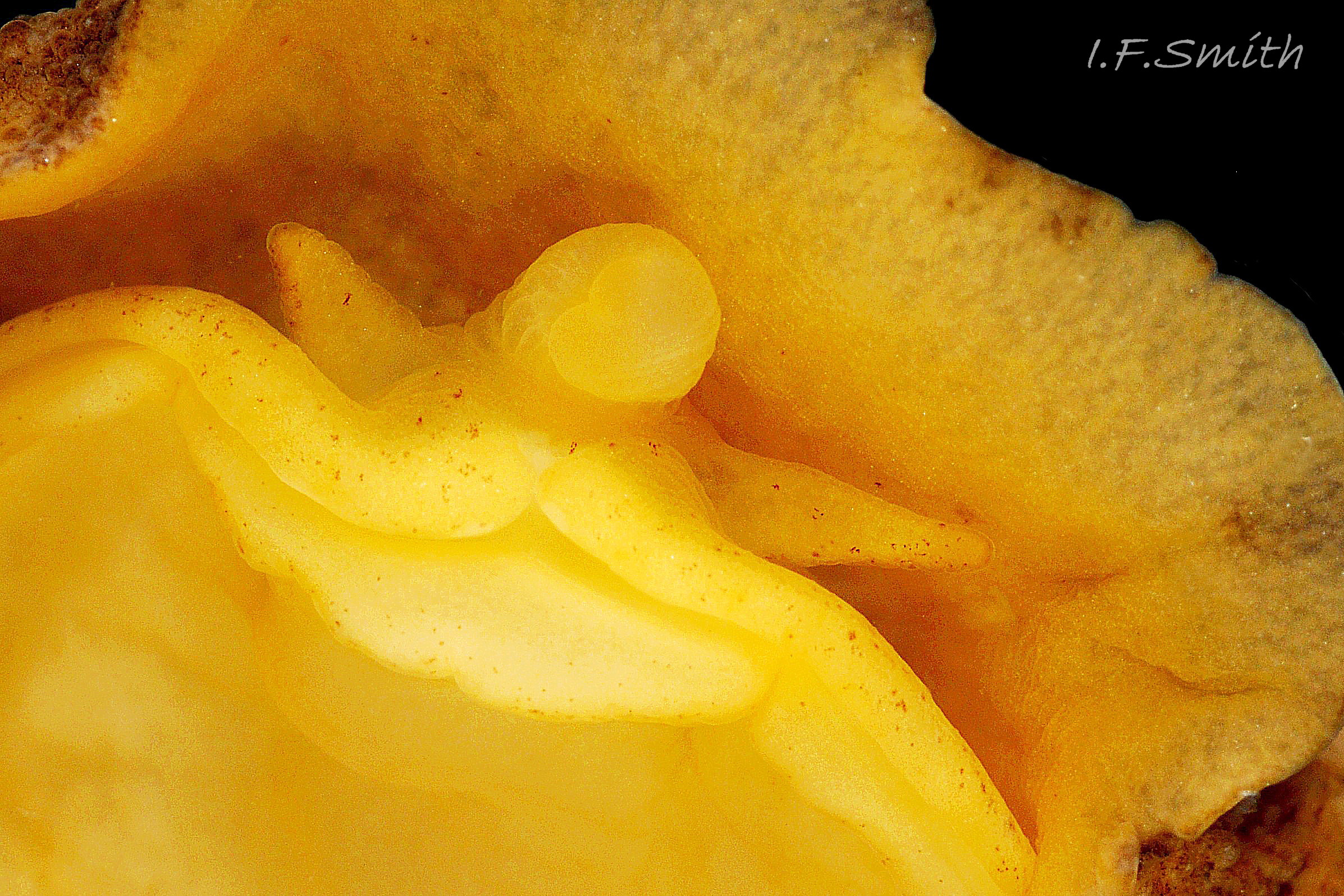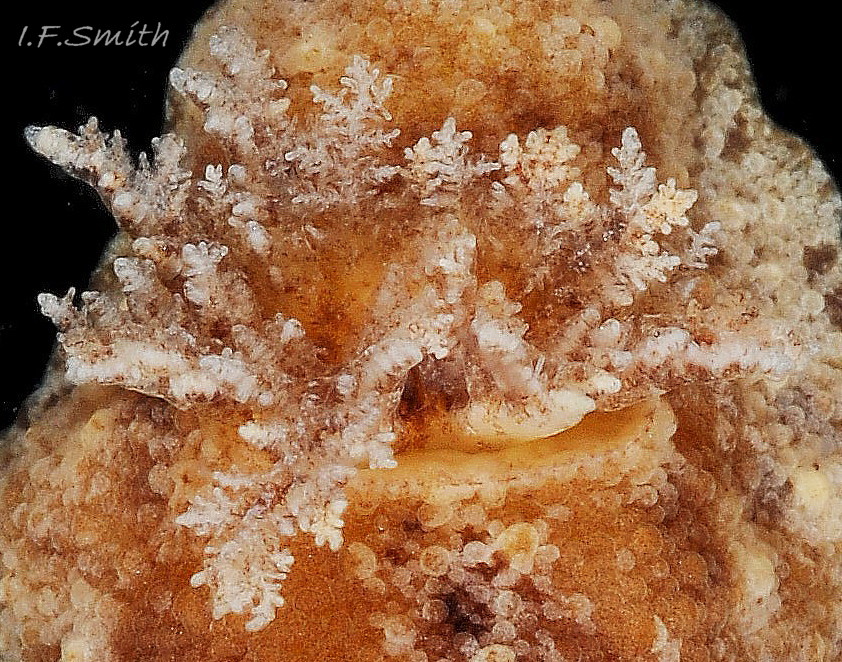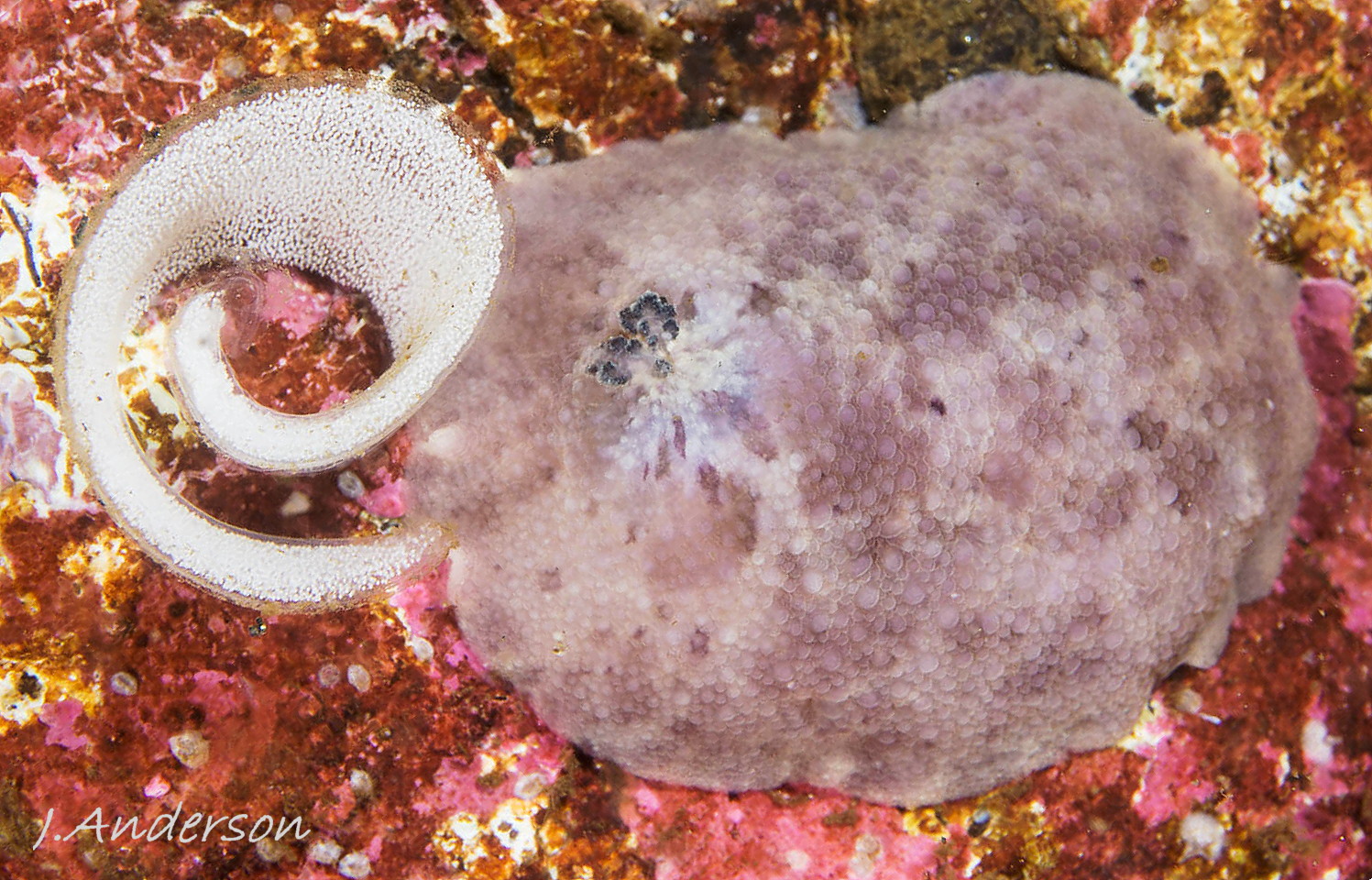Click image to enlarge with full caption. Main text below slider.
Doris pseudoargus Rapp, 1827.
PDF available at www.researchgate.net/publication/360160568_Doris_pseudoar…
Current taxonomy: World Register of Marine Species
www.marinespecies.org/aphia.php?p=taxdetails&id=181228
Synonyms:
Archidoris pseudoargus (Rapp, 1827); Doris tuberculata Cuvier, 1804; Doris flammea Alder & Hancock, 1844 [uncertain, nomen dubium, in WoRMS, but synonym in Thompson & Brown (1984) and opinion of IFS].
Vernacular names: Sea lemon; Lemon môr (Welsh); søcitron (Danish), citroenslak (Dutch); citron de mer (French); Meerzitrone (German).
GLOSSARY BELOW
Description
Doris pseudoargus grows up to 120 mm long. Its size and resemblance to the shape, texture and, frequently, the colour of a lemon 01 Doris pseudoargus have given rise to the vernacular names in many languages. The ample mantle covers the whole body 02 Doris pseudoargus . It is covered with blunt, rounded tubercles of mixed small and large sizes when full grown 03 Doris pseudoargus . The many spicules in the tubercles make the body firm and stiff to touch. The ground colour is usually buff 04 Doris pseudoargus , orange 05 Doris pseudoargus or yellow 01 Doris pseudoargus but, in addition, many have blotches of brown, pink, white, green, purple or red 02 Doris pseudoargus , 03 Doris pseudoargus & 06 Doris pseudoargus and large assortment in Anderson, 2022). The underside of the mantle is uniformly coloured with no markings 07 Doris pseudoargus , but strong dorsal colour may show slightly through the thin translucent periphery 08 Doris pseudoargus .
When fully extended 09 Doris pseudoargus , the rhinophores have a short, smooth, white, cylindrical basal stem below about twenty yellow lamellae forming a tall conoid tapering to a small truncate apex. The lamellae alternate large and small, the latter not extending to the broad anterior face, which consequently shows fewer lamellae. When the rhinophores contract, the stem broadens rapidly at the base and the lamellae close together to form a short stout conoid 10 Doris pseudoargus . The rhinophores can retract into basal pits which have a slightly raised rim bearing tubercles like those on the rest of the mantle.
About nine large, tripinnate gills are arranged in circle, open at the rear, around an anal papilla 11 Doris pseudoargus , which is usually coloured as the mantle. In life the gills are difficult to count; a side view when they are only partially expanded sometimes allows the main stems on one side to be counted 02 Doris pseudoargus . Fully expanded, the gills are voluminous, undulating, semi-prone and often inclined backwards 02 Doris pseudoargus & 03 Doris pseudoargus .
Gill colours are varied. Sometimes they are similar to the ground colour of the mantle 04 Doris pseudoargus . On shores of the Menai Strait, Wales, they often have variable amounts of purple or lilac 03 Doris pseudoargus , 12 Doris pseudoargus & 13 Doris pseudoargus . Sublittorally in Scotland, they are often blackish with pale ribs (Anderson, 2022). D. pseudoargus is cryptobranchiate; when the gills are withdrawn nothing protrudes and the aperture is surrounded by packed white tubercles 14 Doris pseudoargus & 15 Doris pseudoargus . The small head has a vestigial blunt oral tentacle on either side of an oral slit; often only the tips of the tentacles protrude beyond the foot 16 Doris pseudoargus .
The sole of the foot is usually the same as the ground colour of the mantle, buff, white, yellow 07 Doris pseudoargus or orange, without any markings except, occasionally, a continuation of the foot’s pale dorsal freckles around the edge 17 Doris pseudoargus . Translucency sometimes faintly reveals the colour of viscera 07 Doris pseudoargus . The palely freckled dorsal surface of the foot may protrude a little when in motion 18 Doris pseudoargus , and is occasionally visible when the mantle is raised 19 Doris pseudoargus .
Key identification features
Doris pseudoargus
1) Up to 120 mm long.
2) Usually buff, yellow or orange, often with large blotches of bright colours 02 Doris pseudoargus , 03 Doris pseudoargus & 06 Doris pseudoargus .
3) Variously sized spiculose tubercles 03 Doris pseudoargus give stiff unyielding feel to mantle.
4) Gills often blotched with colour, anus similar colour to mantle 03 Doris pseudoargus , 12 Doris pseudoargus & 13 Doris pseudoargus.
5) Underside of mantle lacks dark markings 07 Doris pseudoargus (may show dorsal colour through skirt 08 Doris pseudoargus ).
6) Head small with vestigial oral tentacles 16 Doris pseudoargus .
Similar species
20 Doris pseudoargus , 21 Doris pseudoargus & 22 Doris pseudoargus.
Jorunna tomentosa (species complex needs investigation)
1) Up to 60 mm long, often similar size to medium D. pseudoargus.
2) Sandy, buff, or whitish , any other marks few, small and dark.
3) Very fine tubercles (caryophyllidia); velvety appearance, soft feel.
4) Large pale gills around contrasting dark brown anus.
5) Underside of mantle lacks dark markings.
6) Head has thin distinct oral tentacles.
Geitodoris planata
23 Doris pseudoargus, 24 Doris pseudoargus, 5 25 Doris pseudoargus , 26 Doris pseudoargus & fig 27 27 Doris pseudoargus.
1) Up to 65 mm long.
2) Dull yellow or orange-brown, generally less colourful and variegated than D. pseudoargus. Up to 12 pale vaguely stellate areas on dorsal surface of mantle.
3) Tubercles smaller than larger ones on D. pseudoargus, bigger than on Jorunna tomentosa. Mantle feels even stiffer than D. pseudoargus
4) Gill ring often partially separated into left and right groups.
5) Dark marks on underside of mantle (missing on some).
6) Head has well developed linear oral tentacles.
Habits and ecology
D. pseudoargus lives on the middle and lower shore, and sublittorally to 300 m. It is well camouflaged on its prey; the sponges Halichondria panicea and Hymeniacidon perleve. It exudes defensive chemicals, but has been used for fish bait. Like other nudibranchs it is a simultaneous hermaphrodite. Breeding has been recorded in all months but the majority spawn and die in spring. Juveniles are soon present, but often overlooked until late summer because of their small size. The usual pattern on the Menai Strait, Wales is adults c. 60 mm long in March, spawn and die; juveniles c. 15 mm in April, c. 30 mm in June; large enough for frequent casual observations by late summer; grow over winter; spawn and die in spring. The spawn mass is a large whitish or yellowish, spiral ribbon attached by its edge to hard substrate 28 Doris pseudoargus . Planktonic veliger larvae live for about four weeks before metamorphosis.
Distribution and status
D. pseudoargus occurs from Iceland and northern Norway to Portugal and into the Mediterranean and Baltic as far in as Kiel, GBIF map www.gbif.org/species/5724726 . The GBIF records on the east coast of North America as far south as Cape Cod, are of over ten records with images of littoral and sublittoral images between 2017 and 2021 from iNaturalist (accessed 18 April, 2022); the principal recorder, Alex Shure, reporting having seen hundreds offshore. There seem to be no earlier reports of it from north east America known to regular workers in the area. This suggests a recent arrival in America of this large and, when present, easily detected species (Harris et al., 2022). Records from the Pacific and Gulf of Mexico are probably of other species of similar appearance (Thompson and Brown, 1984). It is widespread round Britain and Ireland, and frequently recorded because its large size makes it easy to notice, UK map species.nbnatlas.org/species/NHMSYS0021006612 .
Acknowledgements
I gratefully thank Jim Anderson and Allan Rowat for use of their images.
References and links
Alder, J. & Hancock, A. 1845-1855. A monograph of the British nudibranchiate mollusca. London, Ray Society. As Doris tuberculata Fam. 1 Pl. 3 www.biodiversitylibrary.org/item/131598#page/96/mode/1up
and as Doris flammea Fam. 1 Pl. 4 www.biodiversitylibrary.org/item/131598#page/102/mode/1up
Anderson, J. (accessed 16 April 2022) Doris pseudoargus (Rapp, 1827) Scottish nudibranchs and sea slugs www.nudibranch.org/Scottish%20Nudibranchs/doris-pseudoarg…
Harris, L. G., Shure, A., Kuzirian, A., Gosliner, T. M. and Donohoo, S. A. 2022. A European nudibranch new to the Gulf of Maine: Doris pseudoargus Rapp, 1827. Biol Invasions www.researchgate.net/publication/364106528_A_European_nud…
iNaturalist Doris pseudoargus observations map, accessed 21 April 2022. www.inaturalist.org/observations?taxon_id=542077
Thompson, T.E. & Brown, G.H. 1984. Biology of opisthobranch molluscs 2. London, Ray Society.
Glossary
bilaminate = formed of two laminae (layers).
caryophyllidia = digital tubercles with terminal knob surrounded by coronet of spikes, like a clove (spice), on some dorid sea slugs.
cryptobranchiate = able to retract gills into a single capacious gill cavity.
dorid = a sea slug in the infraorder Doridoidei; with gills and rhinophores on the dorsum; often shaped like half a lemon or grape.
hermaphrodite, simultaneous = individual acts as both male and female at the same time with similar partner(s).
lamellae = small plates on rhinophores, or leaflets of gill.(sing. lamella)
lamina = layer
mantle = (of nudibranchs) sheet of tissue forming part or all of dorsal body-surface.
nudibranch = a group of seaslugs with no shell when adult in the order Nudibranchia (not all seaslugs are nudibranchs).
papilla = (pl. papillae) small protrusion of flesh.
plankton = animals and plants that drift in pelagic zone (main body of water).
rhinophores = chemo-receptor tentacles on top of head of nudibranch.
spicule = small, slender, sharp-pointed feature mainly composed of calcite (CaCO3) and brucite (Mg(OH)2) .
stellate = resembling a star, with radiating lines.
unipinnate = (of gill plume) un-branched simple leaflets along each side of main rib.
veliger = shelled larva of marine gastropod or bivalve mollusc which swims by beating cilia of a velum (bilobed flap).
